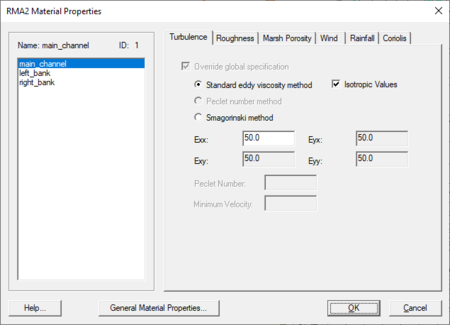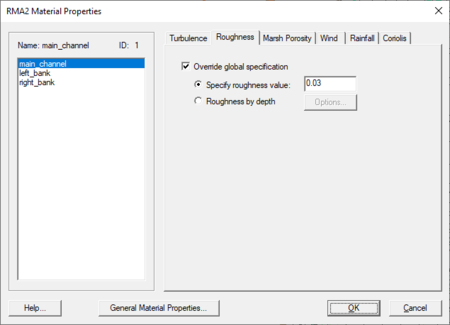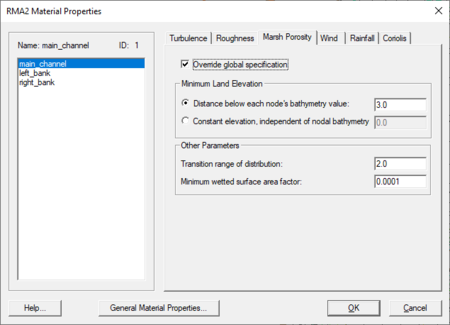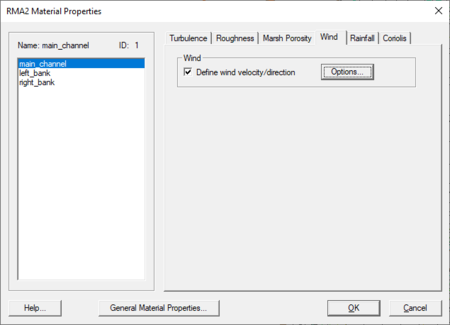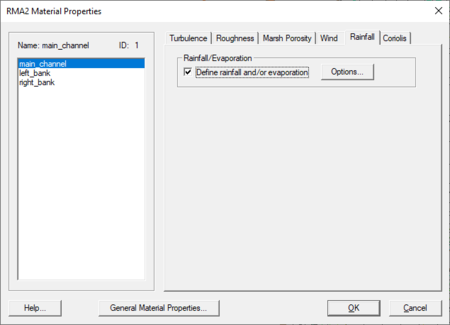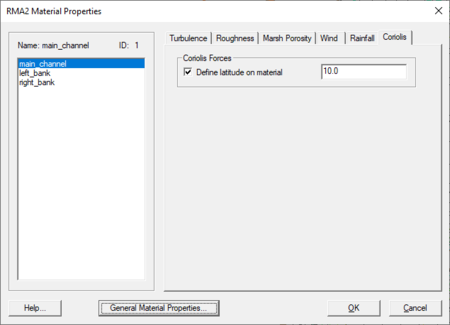SMS:RMA2 Material Properties: Difference between revisions
| Line 45: | Line 45: | ||
The global [http://en.wikipedia.org/wiki/Coriolis_effect coriolis] values (specified in the [[SMS:RMA2 Model Control Dialog|''RMA2 Model Control'']]) can be overridden for each material. | The global [http://en.wikipedia.org/wiki/Coriolis_effect coriolis] values (specified in the [[SMS:RMA2 Model Control Dialog|''RMA2 Model Control'']]) can be overridden for each material. | ||
[[Image:RMA2 MP Coriolis. | [[Image:RMA2 MP Coriolis.png|thumb|none|left|450 px|''RMA2 Material Properties'' dialog showing the ''Coriolis'' tab]] | ||
== Related Topics == | == Related Topics == | ||
Latest revision as of 15:51, 23 July 2019
The RMA2 Material Properties dialog is reached through the RMA2 | Material Properties menu command. For an in depth discussion of the RMA2 material properties, consult the RMA2 Users Guide. [1] [2]
Turbulence
The global turbulence values (specified in the RMA2 Model Control) can be overridden for each material.
- Standard eddy viscosity method
- Exx – The x-momentum of turbulent exchange in the x-direction (lb-sec/ft2 or Pascal-sec for SI-units)
- Exy – The x-momentum of turbulent exchange in the y-direction (lb-sec/ft2 or Pascal-sec for SI-units)
- Eyx – The y-momentum of turbulent exchange in the x-direction (lb-sec/ft2 or Pascal-sec for SI-units)
- Eyy – The y-momentum of turbulent exchange in the y-direction (lb-sec/ft2 or Pascal-sec for SI-units)
- Note: 1 lb-sec/ft2 = 47.879 Pascal-sec
- Smagorinski method
- TBFACT – Smagorinsky coefficient for turbulent exchange. A negative value applies the default coefficient (0.05).
- TBFACTS – Not applied in RMA2. Smagorinsky coefficient for diffusion (Vorticity). A negative value applies the default coefficient (0.05).
- TBMINF – Smagorinsky minimum turbulent exchange factor. A negative value applies the default coefficient (1.0).
- TBMINFS – Not applied in RMA2. Smagorinsky minimum diffusion (Vorticity) factor. A negative value applies the default coefficient (1.0).
Roughness
The global roughness value (specified in the RMA2 Model Control) can be overridden for each material. The material roughness can be specified as a single value, or depth dependent.
Marsh porosity
The global marsh porosity values (specified in the RMA2 Model Control) can be overridden for each material. Since wetting and drying cause abrupt changes to the shape of the finite element mesh, numerical stability problems can result when wetting and drying occurs. In an attempt to address the fact that wetting and drying is a continuous process, while the mesh is a discreet data set, marsh porosity was implemented for RMA2. When marsh porosity is used, elements are considered "dry" only if ALL nodes on the element are dry.
Abrupt changes in the marsh porosity parameters between adjacent node can lead to divergence. The results from a simulation using marsh porosity can be difficult to interpret due to the fact that partly dry marsh elements appear completely wet even thought the water surface elevation is lower than part of the element.
Marsh porosity is only available when running a dynamic RMA2 simulation.
Wind
According to the RMA2 model documentation, "Because of lack of experience in using storms in a simulation, this feature remains experimental."
Wind shear stress at the water surface is caused by friction between the moving air and water. The shear stress coefficient is a function of wind speed. The global wind values (specified in the RMA2 Model Control) can be overridden for each material.
Wind parameters are only available when running a dynamic RMA2 simulation.
Rainfall
The global rainfall and evaporation values (specified in the RMA2 Model Control) can be overridden for each material.
Coriolis
The global coriolis values (specified in the RMA2 Model Control) can be overridden for each material.
Related Topics
SMS – Surface-water Modeling System | ||
|---|---|---|
| Modules: | 1D Grid • Cartesian Grid • Curvilinear Grid • GIS • Map • Mesh • Particle • Quadtree • Raster • Scatter • UGrid |  |
| General Models: | 3D Structure • FVCOM • Generic • PTM | |
| Coastal Models: | ADCIRC • BOUSS-2D • CGWAVE • CMS-Flow • CMS-Wave • GenCade • STWAVE • WAM | |
| Riverine/Estuarine Models: | AdH • HEC-RAS • HYDRO AS-2D • RMA2 • RMA4 • SRH-2D • TUFLOW • TUFLOW FV | |
| Aquaveo • SMS Tutorials • SMS Workflows | ||
